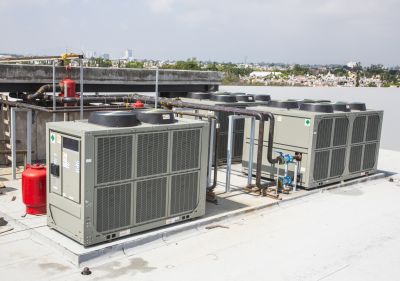Top-Rated Commercial AC Components for Efficient Climate Control
Browse a selection of reliable parts and systems tailored for commercial environments to achieve consistent and effective cooling.
 Commercial air conditioning installations require a range of specialized products designed to ensure efficient, reliable, and safe operation. From large-scale cooling units to essential accessories, selecting the right equipment is crucial for maintaining comfortable indoor environments in commercial spaces. Proper installation and maintenance depend on choosing components that meet the specific demands of the building size, usage, and airflow requirements. Understanding the variety of available products can help facility managers and contractors make informed decisions tailored to their installation needs.
Commercial air conditioning installations require a range of specialized products designed to ensure efficient, reliable, and safe operation. From large-scale cooling units to essential accessories, selecting the right equipment is crucial for maintaining comfortable indoor environments in commercial spaces. Proper installation and maintenance depend on choosing components that meet the specific demands of the building size, usage, and airflow requirements. Understanding the variety of available products can help facility managers and contractors make informed decisions tailored to their installation needs.
Top Overall Option
Commercial Air Handling Unit
A versatile and scalable air handling unit designed for large-scale commercial applications, offering customizable configurations to match specific cooling and ventilation needs. It features durable construction, efficient airflow management, and compatibility with various control systems, making it a reliable choice for complex installations.
Types of Products For Commercial Ac Installations
Central Air Conditioning Units
Large capacity systems that centralize cooling for entire buildings, typically connected to ductwork for even distribution.
Ductless Mini-Split Systems
Flexible cooling solutions that do not require ductwork, suitable for specific zones or retrofit applications.
Air Handling Units
Systems that condition and circulate air, often used in large commercial environments for ventilation and climate control.
Evaporator Coils
Key components that absorb heat from the air, essential for heat exchange in cooling systems.
Condenser Units
Outdoor units that expel heat from the refrigerant, crucial for the cooling cycle.
Thermostats and Control Panels
Devices that regulate temperature and system operation, often programmable for energy efficiency.
Refrigerant Piping and Fittings
Components that connect various parts of the cooling system, ensuring proper refrigerant flow.
Vibration Isolators
Accessories that reduce noise and vibration from large equipment during operation.
Air Filters
Essential for maintaining indoor air quality and protecting system components.
Dampers and Louvers
Control airflow within ductwork, enabling zone-specific cooling and ventilation.
Electrical Contactors and Relays
Support high electrical loads and ensure safe operation of the AC system.
Smart Monitoring Devices
Allow remote system management and diagnostics for proactive maintenance.
Insulation Materials
Help prevent energy loss in refrigerant lines and ductwork.
Pipe Insulation and Clamps
Secure and insulate refrigerant piping for efficient operation.
Drain Pans and Pumps
Manage condensate removal to prevent water damage and mold growth.
Expansion Valves
Control refrigerant flow and pressure within the system for optimal performance.
Filter Driers
Protect the system from moisture and contaminants in the refrigerant line.
Popular Choices
Commonly used for zoned cooling in commercial spaces, offering flexibility and ease of installation.
All-in-one systems designed for rooftop installation, suitable for various commercial settings.
Advanced systems that enable precise temperature control across multiple zones with variable capacity.
Discreet indoor units that distribute air evenly within commercial spaces.
Compact units used to regulate air temperature in individual zones or rooms.
Support large-scale HVAC systems by removing heat from condenser water.
Smart or programmable thermostats that optimize system performance and energy use.
Tools and components for maintaining refrigerant levels and system health.
Components that facilitate airflow distribution and indoor air quality management.
Support the electrical needs of large AC systems with safety and reliability.
Enhance indoor air quality with high-efficiency filters.
Enable real-time tracking and diagnostics for commercial HVAC systems.
Assist in safe refrigerant handling and system maintenance.
Efficiently remove excess moisture from indoor units.
Reduce operational noise for quieter indoor environments.
Manage airflow and temperature in specific areas within a building.
Support heat transfer processes in various HVAC configurations.
The core of any commercial AC system often revolves around the air handling units and central cooling units. These units are responsible for the primary cooling function and are typically designed to handle higher capacities compared to residential systems. Additional components such as ductwork, thermostats, and control systems play vital roles in ensuring optimal performance and energy efficiency. Accessories like filters, dampers, and vibration isolators contribute to system longevity and reduced operational noise.
Installation of commercial AC systems also involves selecting appropriate electrical components, including contactors, relays, and circuit breakers, to support the robust electrical demands. Proper refrigerant management components are essential for maintaining system performance and compliance with safety standards. As these systems are often complex and large-scale, integrating smart controls and monitoring devices can facilitate easier maintenance, troubleshooting, and adjustments over the lifespan of the installation. Ensuring compatibility and quality across all product types is key to successful commercial air conditioning setups.
Key Buying Considerations
- Determine the cooling capacity required based on the size and usage of the space.
- Assess compatibility with existing HVAC infrastructure and ductwork.
- Consider energy efficiency ratings to optimize operational costs.
- Evaluate system control options, including programmable and smart features.
- Check for ease of maintenance and availability of replacement parts.
- Review the noise levels produced by the units to ensure a comfortable environment.
- Understand refrigerant type and management requirements for safety and compliance.
- Ensure the product's durability and suitability for the commercial environment.
- Verify electrical requirements and compatibility with facility power supplies.
- Look into installation requirements and space constraints for indoor and outdoor units.
- Consider the scalability of the system for future expansion or upgrades.
- Evaluate the warranty and support services offered by the manufacturer.
- Check for compliance with local safety and building codes.
- Assess the quality and reputation of the product components and materials.
- Review user feedback and professional recommendations for reliability insights.
